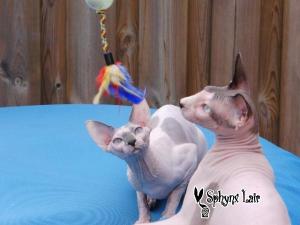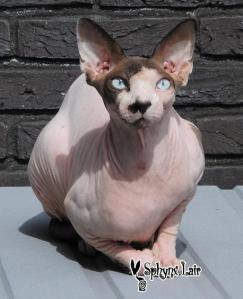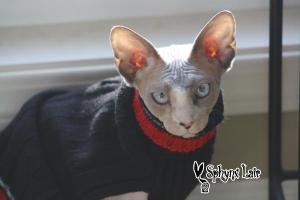What is Tritrichomonas foetus?
In layman terms? it’s a single-celled organism. The longer version of this critter is that this is a flagellate, a single-celled organism possessing hair or lash-like structures, called “flagella,” on its “body” which wiggle around allowing the ugly bug to move. Tritrichomonas foetus is commonly mistaken for Giardia, another pesky parasitic flagellate as they both use “flagella” to move around and both have similar shaped bodies.
How do cats get infected with Tritrichomonas foetus?
The Tritrichomonas foetus organisms are in the feces (poop) of an infected cat. The most common transmission happens when multiple cats share a litter box, this is where the organism can live up to 3 days in fecal material (poop). Any time the cat or cats step into the litter box, they can possibly step in the feces of a potential infected cat or cats, there, the organisms can be transferred to the paws and nails of your cats and then while cleaning and grooming themselves, enter the body of the cat through the mouth.
What are the symptoms of Tritrichomonas foetus?
Tritrichomonas foetus colonizes the lower intestine of the cat causing the mucous and sometimes bloody diarrhea that characterizes colitis. If the colon is biopsied, inflammatory cell infiltration typical of inflammatory bowel disease will be seen. Not all infected cats have diarrhea; many cats especially older ones have no symptoms at all but are still contagious to other cats.
Because colitis can have so many causes, it is important to keep this possible cause in mind. Chronic colitis may or may not respond to symptomatic treatment and if a specific underlying cause can be identified and treated, a long-term difficult problem can be potentially resolved permanently. Many colitis remedies will lead to temporary improvement for a Tritrichomonas-infected cat but the symptoms generally come right back after treatment ceases.
Diagnosis of Tritrichomonas foetus
There are presently four testing methods that can be used to identify Tritrichomonas foetus in a cats fecal sample. It is important that a proper fecal sample be taken from your cat, not the typical scoop it up from the litter box sample! For testing the fecal sample must be freshly obtained with a deeply inserted fecal loop, or flushed from the colon with a syringe. If the cat has been on antibiotics, this will interfere with testing; the cat should be completely off antibiotics for at least a couple of days!
Direct Smear
Fecal matter is swabbed onto a microscope slide, mixed with a saline solution, and examined for the presence of flagellate organisms. The feces must be immediately fresh from the rectum. The more fresh and more mucous In the animals sample, the better for testing. Usually multiple slides must be examined as this pesky organism is very elusive. Standard fecal tests for parasites will not pick up this organism. Refrigeration of the sample will kill the organism and make it impossible to detect. Again as stated above, If the cat is on antibiotics the number of organisms available to detect will be greatly reduced even though most antibiotics cannot cure the infection.
While this is a relatively easy test to perform, it only has about a smaller chance of detecting a natural Tritrichomonas foetus infection. A more sensitive test is generally preferred.
Culture (also called the “Pouch Test” Best method!)
A special culture bag can be used to grow Tritrichomonas foetus in numbers large enough for detection. The feces used must be freshly obtained from the rectum as stated before, inoculated into the pouch, and the pouch is kept in a vertical position for 12 days at room temperature. The pouch is periodically examined under the microscope for the presence of organisms.
This is the test method of choice in most cases as it is easy to perform, reasonably priced and generally accurate.
PCR Testing (Polymerase Chain Reaction Testing)
PCR testing is a DNA test for the presence of Tritrichomonas foetus. A larger fecal sample is needed and the test must be done at a reference lab. It is generally reserved for patients where the Pouch test has been negative but the index of suspicion is still high.
PCR testing is the most sensitive of all the test methods but is also fairly expensive. Specialized equipment is needed and only a few laboratories are qualified to run samples.
Biopsy
A routine colon biopsy is unlikely to find this parasite; special stains on the tissue (“immunohistochemistry”) must be requested and at least six tissue samples must be examined. This is the most invasive form of testing and would not be done right off the bat but if the cat is going to have a biopsy for chronic colitis anyway, it might be a good idea to have the pathologist look for Tritrichomonas foetus.
Keep in mind! A negative test result does not rule out Tritrichomonas infection
no matter which test is performed.
Treatment for Tritrichomonas foetus
In the past, several different antibiotics have been reported to be effective on Tritrichomonas foetus.
The only drug that is felt to be reliable against Tritrichomonas foetus is ronidazole, and its use is far from straight-forward. Here is information you should to know:
Ronidazole must be compounded to get a dose in a suitable size for cats.
Ronidazole is not licensed for use in cats; it is a poultry antibiotic. It also tastes very bad and should be provided in capsules rather than as an oral liquid (It tastes horrible!).
You must handle with care if you choose to administer the drug! You must wear gloves when handling Ronidazole.
The most common side effect in cats when treating with Ronidazole is neurotoxicity which means it is not appropriate to use Ronidazole as a trial to see if a cat with colitis improves on it. Ronidazole should be used only in confirmed Tritrichomonas foetus feline patients!
Neurotoxicity effects: loss of appetite, incoordination, and possibly seizures. Some experts recommend engaging the cat in play on a daily basis to assess muscular coordination and agility.
Cats being treated should be isolated from other cats in the home to prevent reinfection!
It is not possible to fully confirm that An infection has been eradicated as a negative PCR test does not rule out infection. Experts recommend a PCR test in 1-2 weeks after treatment and again approximately 20 weeks after treatment.
Ronidazole is usually given once daily for two weeks. The diarrhea should be resolved by the end of this course if all goes well with treatment.










